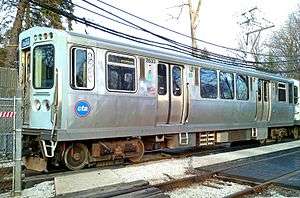O'Hare station train crash
 A 2600 series train, similar to that involved in the accident. | |
| Date | March 24, 2014 |
|---|---|
| Time | 2:50 a.m. CDT |
| Location | O'Hare station |
| Coordinates | 41°58′52″N 87°54′03″W / 41.98111°N 87.90083°WCoordinates: 41°58′52″N 87°54′03″W / 41.98111°N 87.90083°W |
| Country | United States |
| Rail line | CTA Blue Line |
| Operator | Chicago Transit Authority |
| Type of incident | Overran bumper |
| Cause | Operator falling asleep at controls |
| Statistics | |
| Trains | 1 |
| Injuries | 34 |
| Damage | $11,196,796 |
On March 24, 2014, a Chicago Transit Authority (CTA) passenger train overran the bumper at the O'Hare station, injuring 34 people.
Accident
At 2:50 a.m. local time (07:50 UTC), a passenger train overran the bumper at the O'Hare station. The front car of the eight-car train partially ascended an escalator.[1] A spokesman stated that it was likely that the train entered the station at too high a speed.[2] It was later estimated that the train entered the station at 25 to 26 miles per hour (40 to 42 km/h), which was not an excessive speed.[3] At least 50 firefighters and paramedics attended the accident.[4] Thirty-four people were injured.[5] They were taken to the Advocate Lutheran General Hospital, the Our Lady of the Resurrection Medical Center, the Resurrection Hospital and the Swedish Covenant Hospital.[1]

Following the accident, the line between O'Hare and Rosemont was closed, with a replacement bus service in place. A CTA spokesman initially stated that the line could be closed for as long as 48 hours while recovery of the train was undertaken.[1] This was later revised upwards to a week.[3] The front two cars of the train were damaged in the accident.[1] Damage was estimated at $6,000,000. On March 26, work began to scrap the lead car in situ.[6] The derailed train was removed from the station on March 27.[7] The station reopened on March 30, 2014 at 2:00 p.m. The escalator damaged in the crash was replaced by stairs.[8] Damage amounted to $11,196,796.[5]
Train
Photographs show that the train involved in the accident was made up of four two-car 2600 series trainsets, with 3061/3062 as the leading pair.[9][10]
Investigation
The National Transportation Safety Board (NTSB) opened an investigation into the accident. Investigators focused on the theory that the motorwoman, 25-year-old Brittney Tysheka Haywood,[11] fell asleep at the controls.[1] She stated that she had recently performed "a lot of overtime".[12] When interviewed by the NTSB, she admitted falling asleep at the controls and disclosed that she had done a similar thing the previous month, which resulted in an overshoot at Belmont station on February 1. She did not reveal to CTA that she had fallen asleep when questioned about the overshoot.[13][14] The investigation was hampered by the train's lack of a train event recorder, although it was fitted with a video camera. The recording from the camera was examined.[1] Images from 41 cameras within the station were also studied.[3] The NTSB's report ultimately confirmed the original findings.[15][16]
Aftermath
As a direct consequence of the accident, the CTA reduced the speed limit into the O'Hare station from 25 miles per hour (40 km/h) to 15 miles per hour (24 km/h). The area of the speed limit was also extended away from the station.[14]
References
- 1 2 3 4 5 6 Nickeas, Peter; Bowean, Lolly; Wronski, Richard; Geiger, Kim. "Focus in CTA crash falls on operator fatigue, braking system". Chicago Tribune. Retrieved March 24, 2014.
- ↑ "Chicago airport train derailment injures 32". BBC News Online. Retrieved March 24, 2014.
- 1 2 3 Esposito, Stefano. "'Automatic stop' kicked in before CTA train crashed at O'Hare". Chicago Sun Times. Retrieved March 24, 2014.
- ↑ Nickeas, Peter. "'I got tossed from one end of the train to the other'". Chicago Tribune. Retrieved March 24, 2014.
- 1 2 "Board Meeting : Chicago Transit Authority Train Collides with Bumping Post and Escalator at O'Hare Station". National Transportation Safety Board. Retrieved April 21, 2015.
- ↑ Keyser, Jason. "NTSB: Train operator asleep before Chicago crash". WIST. Associated Press. Retrieved March 26, 2014.
- ↑ "Derailed train removed from O'Hare, station to reopen this weekend". Chicago Sun Times. March 28, 2014. Retrieved March 31, 2014.
- ↑ Seidel, Jon; Charles, Sam (March 30, 2014). "Blue Line station at O'Hare, scene of derailment, reopens". Chicago Sun Times. Retrieved March 31, 2014.
- ↑ "Police: Commuter train derails at Chicago airport". WAVY. March 24, 2014. Retrieved April 5, 2014.
- ↑ Esposito, Stefano; Rossi, Rosalind; Owen, Jordan; Slefo, George P. "Blue Line train derails at O'Hare, climbs up escalator; 32 hurt". Chicago Sun Times. Retrieved March 24, 2014.
- ↑ Goudie, Chuck. "Train operator identified in Blue Line crash". WLS-TV ABC 7. Retrieved April 1, 2014.
- ↑ "Union: Chicago train operator 'extremely tired'". Crain's Chicago Business. March 24, 2014. Retrieved March 25, 2014.
- ↑ Wronski, Richard. "NTSB: CTA operator admitted falling asleep before O'Hare crash". Chicago Sun Times. Retrieved March 26, 2014.
- 1 2 Esposito, Stefano; Rossi, Rosalind. "CTA operator awoke 'when she hit,' dozed off before, NTSB says". Chicago Sun Times. Retrieved March 27, 2014.
- ↑ "Train driver in O'Hare CTA crash told investigators, 'I'm not clear as to when I actually ... dozed off'". Chicago Tribune. March 27, 2015. Retrieved October 14, 2015.
- ↑ Hilkevitch, Jon (April 28, 2015). "NTSB report: Blue Line crash shows CTA should update, add safety systems". Chicago Tribune. Retrieved October 14, 2015.